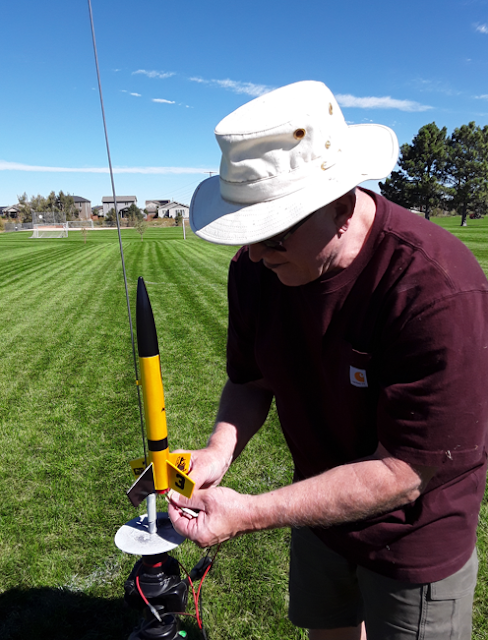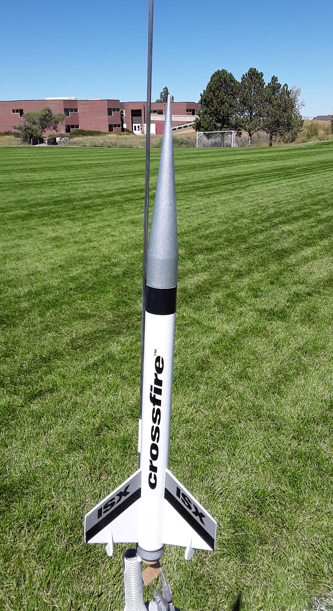Thursday, September 7th, saw an absolutely perfect day for flying model rockets in Castle Rock, Colorado. Mike Perreault and I made the short trek to Founders Park to do just that.
The weather conditions couldn't have been any better - temperatures in the high 70s to low 80s, and virtually no wind! There were only a few brief occasions where a light breeze blew across the field for a few seconds, then it was back to dead calm.
Normally, Founders Park is a 'B6-4 field' but today was definitely a day to bring out the C and D motors- which we did!
As it turned out, only one of our flights drifted a short distance outside the field perimeter. Most landed very nearby, and a couple even touched down next to the launch pads.
The first bird to ply the skies was Mike's Mini Honest John, a veteran of several previous flights.
The model flew perfectly on A10 power. This flight session marked Mike's first use of a newly built camera tripod launch pad, complete with a drill chuck to hold the launch rods.
My first bird off the pad was the EAC Viper, turning in a perfect B6-4 flight.

At the beginning of this launch session, we had noted that there was a Castle Rock Fire truck parked in the parking lot, and several members of the Town's Fire and Rescue Team present.
At each of the first launches, a cheer went up from the firemen as the rockets reached apogee and deployed their parachutes.
To my surprise, one of the firemen ran into position and caught my Viper before it drifted to the ground!
After talking a bit to the team member, we learned that they were at the park to conduct some fire hose training exercises. The gentlemen hung around for several more of our launches.
Next up was Mike's "Doorbell", actually a down-scaled version of the Doorknob.
Here's a shot of Mike preparing to launch the bird on its maiden flight, powered by a B6-4.
A C6-5 motor sent the Doorbell off for its second flight....
Next up was my ESAM-58 model, flying on a C6-5.
The model lifted off, flew to maybe 150 feet altitude, nosed over and streaked in for a perfect core sample! I remarked to Mike during mid-flight that something was seriously wrong. There was also no discernable ejection charge after the model had impacted.
In the liftoff picture below, it can be noted that the gas plume is way too small for a normal C6 motor and that it appears to be canted off to the side. The smoke trail also looks a bit irregular. Enlarging the photo, a small red object appears adjacent to the jet. I surmise this might be a fragment of the aft body tube being blown off the model.
A definite motor CATO!
Surprisingly, the nose and the front end of the body tube both sustained absolutely no damage.
Not even a paint scratch.
The back end, however, was totally roached.
I might write a future blog post on this one once I perform a thorough failure analysis examination. I think the upper part of the rocket can be salvaged and flown again in some form.
The next bird out of my model box was the Quest Nike-K.
Flying on a C5-3 motor, the attractive model turned in a perfect flight...
This one was also caught mid-air and returned by one of our friendly neighborhood firemen!
Mike Perreault preparing his Goblin for its maiden flight.
Liftoff on a B6-4 for a perfect run. The model is the only one of the day to drift a little bit outside the park boundaries. Mike received his first 'tall weeds landing site' rite of passage for model recovery.
The Goblin ready for its second flight. Another first for Mike: a D motor launch. The bird is airbrush painted with a candy yellow finish.
A great D motor liftoff. The bird returned close to the launch area under dual streamers after a very high flight.
My next bird selected from the on-field arsenal was the Big Daddy...
Beautiful flight and recovery on a D12-3 motor.
Mike's candy-red Red Max ready for flight. B6-4 power.
Next up was my Interceptor. I had intended to launch it on a C6-5, but the only ones of that type I had in the range box were of the same date code that had just trashed my ESAM. I chose to go with a B6-4 instead.
The model boosted perfectly with the parachute ejecting precisely at apogee.
The bird drifted softly down to land right next to Mike's range box!
Here is the C6-5 powered liftoff shot of the second launch of Mike's Red Max.
Beautiful bird!
Mike soon had his Patriot model ready for flight...
...and I had my Griffin-2 set to go at about the same time.
So, we decided to go for a simultaneous drag-race style launch.
The B6-4 powered Patriot left the pad first....
...followed a half second later by the Griffin, also on a B6-4.
A very young child and his grandmother were at the park perimeter and watched the launches.
My bird had landed in a tall shrub which was near their position. I was able to barely reach the parachute and drag the model out of the branches.
Mike showed up with his recovered Patriot, so we stopped and chatted with the visitors for awhile.
Perhaps, a future rocketeer in the making?
Soon enough, Mike had his Bullpup prepped and on the pad.
A perfect C6-7 launch and recovery!
The final two flights of the session were also done in drag race fashion.
Here is Mike's Purple Haze...
...and my Crossfire ISX.
Again, Mike's bird left the pad first on a B6-4 motor.
Followed closely by the Crossfire on an A8-3.
With sixteen flights completed it was time to pack 'em up and head out.
With perfect flying weather and only one model mishap, it was a very satisfying launch session.
On a final note, Mike and I made the short trek to visit the tall pine tree at the south end of the park where, back in June, David Frey's E20-powered Hi Flier XL ("Skylicker") had hung up 40 feet off the ground, not to be retrieved.
We were just checking to see if there were any vestiges of the model to be found.
Nothing.
Either the bird had blown off the tree on its own to have its remnants found by a passer-by, or the model had been removed at some point by Park and Rec. personnel (the most likely scenario).
I like to think that the model was completely devoured and digested by the RET, resulting in a sudden growth spurt!
Cheers!




































